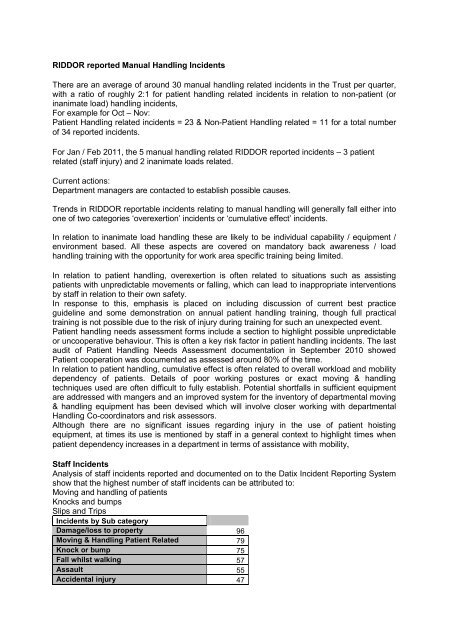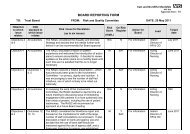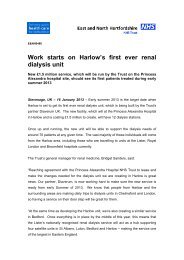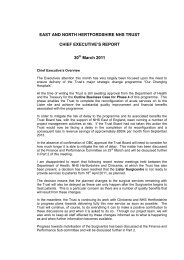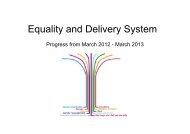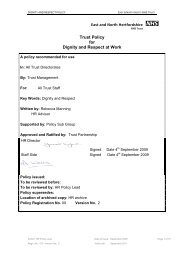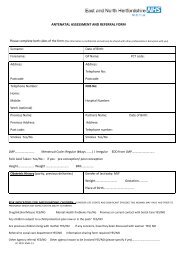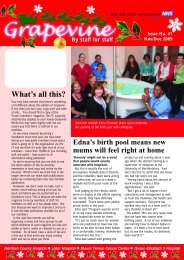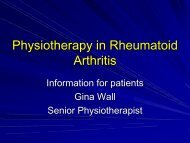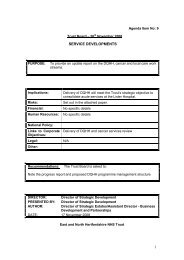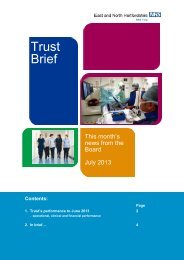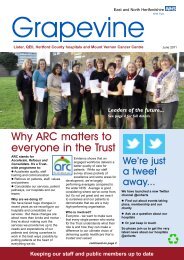Safety & security report - East and North Herts NHS Trust
Safety & security report - East and North Herts NHS Trust
Safety & security report - East and North Herts NHS Trust
Create successful ePaper yourself
Turn your PDF publications into a flip-book with our unique Google optimized e-Paper software.
RIDDOR <strong>report</strong>ed Manual H<strong>and</strong>ling IncidentsThere are an average of around 30 manual h<strong>and</strong>ling related incidents in the <strong>Trust</strong> per quarter,with a ratio of roughly 2:1 for patient h<strong>and</strong>ling related incidents in relation to non-patient (orinanimate load) h<strong>and</strong>ling incidents,For example for Oct – Nov:Patient H<strong>and</strong>ling related incidents = 23 & Non-Patient H<strong>and</strong>ling related = 11 for a total numberof 34 <strong>report</strong>ed incidents.For Jan / Feb 2011, the 5 manual h<strong>and</strong>ling related RIDDOR <strong>report</strong>ed incidents – 3 patientrelated (staff injury) <strong>and</strong> 2 inanimate loads related.Current actions:Department managers are contacted to establish possible causes.Trends in RIDDOR <strong>report</strong>able incidents relating to manual h<strong>and</strong>ling will generally fall either intoone of two categories ‘overexertion’ incidents or ‘cumulative effect’ incidents.In relation to inanimate load h<strong>and</strong>ling these are likely to be individual capability / equipment /environment based. All these aspects are covered on m<strong>and</strong>atory back awareness / loadh<strong>and</strong>ling training with the opportunity for work area specific training being limited.In relation to patient h<strong>and</strong>ling, overexertion is often related to situations such as assistingpatients with unpredictable movements or falling, which can lead to inappropriate interventionsby staff in relation to their own safety.In response to this, emphasis is placed on including discussion of current best practiceguideline <strong>and</strong> some demonstration on annual patient h<strong>and</strong>ling training, though full practicaltraining is not possible due to the risk of injury during training for such an unexpected event.Patient h<strong>and</strong>ling needs assessment forms include a section to highlight possible unpredictableor uncooperative behaviour. This is often a key risk factor in patient h<strong>and</strong>ling incidents. The lastaudit of Patient H<strong>and</strong>ling Needs Assessment documentation in September 2010 showedPatient cooperation was documented as assessed around 80% of the time.In relation to patient h<strong>and</strong>ling, cumulative effect is often related to overall workload <strong>and</strong> mobilitydependency of patients. Details of poor working postures or exact moving & h<strong>and</strong>lingtechniques used are often difficult to fully establish. Potential shortfalls in sufficient equipmentare addressed with mangers <strong>and</strong> an improved system for the inventory of departmental moving& h<strong>and</strong>ling equipment has been devised which will involve closer working with departmentalH<strong>and</strong>ling Co-coordinators <strong>and</strong> risk assessors.Although there are no significant issues regarding injury in the use of patient hoistingequipment, at times its use is mentioned by staff in a general context to highlight times whenpatient dependency increases in a department in terms of assistance with mobility,Staff IncidentsAnalysis of staff incidents <strong>report</strong>ed <strong>and</strong> documented on to the Datix Incident Reporting Systemshow that the highest number of staff incidents can be attributed to:Moving <strong>and</strong> h<strong>and</strong>ling of patientsKnocks <strong>and</strong> bumpsSlips <strong>and</strong> TripsIncidents by Sub categoryDamage/loss to property 96Moving & H<strong>and</strong>ling Patient Related 79Knock or bump 75Fall whilst walking 57Assault 55Accidental injury 47


